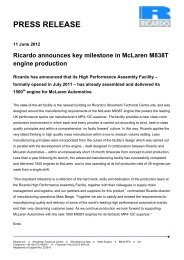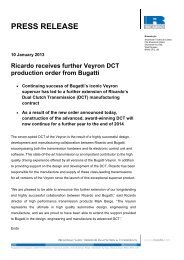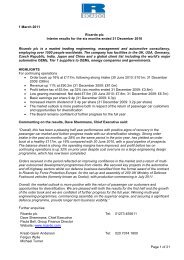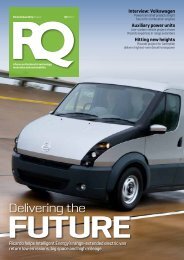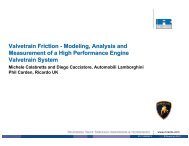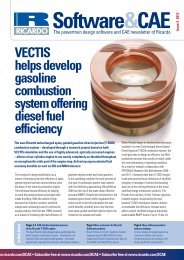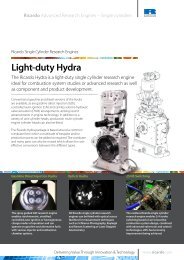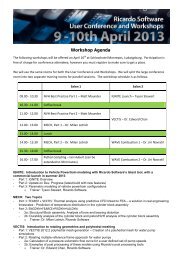CASE STUDY USING PISDYN OF THE EFFECT ON ... - Ricardo
CASE STUDY USING PISDYN OF THE EFFECT ON ... - Ricardo
CASE STUDY USING PISDYN OF THE EFFECT ON ... - Ricardo
You also want an ePaper? Increase the reach of your titles
YUMPU automatically turns print PDFs into web optimized ePapers that Google loves.
Wear and friction simulation<br />
Simulation type A showed that increasing the connecting rod length would reduce skirt friction<br />
loss by 1.0%. The maximum instantaneous wear load and maximum cumulative wear load were<br />
also predicted to be lower if the longer connecting rod is used, so scuffing or excessive wear<br />
should not occur if the longer conrod is used.<br />
The wear pattern predicted by simulation type B if the longer connecting rod is used is shown in<br />
Figure 7. This is clearly suitable and as seen by comparison with Figures 1 and 2, quite<br />
comparable to that produced when the original connecting rod was used.<br />
C<strong>ON</strong>CLUSI<strong>ON</strong>S<br />
The conclusions of the feasibility study using <strong>PISDYN</strong> of the effect on piston performance of<br />
increasing the connecting rod length by 7.9% in the particular four-cylinder petrol engine are:<br />
1. There will not be a danger of piston scuffing and the wear pattern will have little change.<br />
2. There will be little change in skirt frictional power loss.<br />
3. There will be little change in “croak” noise.<br />
4. There will be a significant increase in “rattle” noise amounting to about five decibels.<br />
Given the piston was found to be very quiet under “rattle” conditions when the original<br />
conrod was used, it is possible that the “rattle” noise with the new connecting rod will<br />
still be acceptable.<br />
The broader conclusions of this work are that:<br />
1. The <strong>PISDYN</strong> simulation package can be used to successfully optimise skirt profile, skirt<br />
contour, pin offset and other piston specifications to meet quietness, wear resistance,<br />
friction and durability design requirements.<br />
8 of 13





